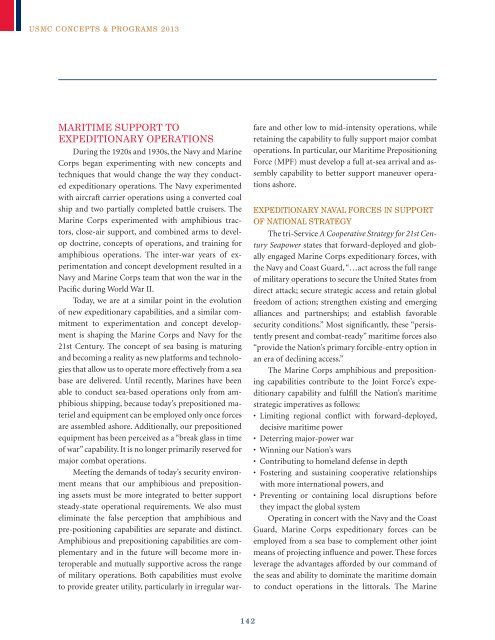USMC Concepts & Programs 2013 - Defense Innovation Marketplace
USMC Concepts & Programs 2013 - Defense Innovation Marketplace
USMC Concepts & Programs 2013 - Defense Innovation Marketplace
Create successful ePaper yourself
Turn your PDF publications into a flip-book with our unique Google optimized e-Paper software.
<strong>USMC</strong> <strong>Concepts</strong> & <strong>Programs</strong> <strong>2013</strong><br />
MARITIME SUPPORT TO<br />
EXPEDITIONARY OPERATIONS<br />
During the 1920s and 1930s, the Navy and Marine<br />
Corps began experimenting with new concepts and<br />
techniques that would change the way they conducted<br />
expeditionary operations. The Navy experimented<br />
with aircraft carrier operations using a converted coal<br />
ship and two partially completed battle cruisers. The<br />
Marine Corps experimented with amphibious tractors,<br />
close-air support, and combined arms to develop<br />
doctrine, concepts of operations, and training for<br />
amphibious operations. The inter-war years of experimentation<br />
and concept development resulted in a<br />
Navy and Marine Corps team that won the war in the<br />
Pacific during World War II.<br />
Today, we are at a similar point in the evolution<br />
of new expeditionary capabilities, and a similar commitment<br />
to experimentation and concept development<br />
is shaping the Marine Corps and Navy for the<br />
21st Century. The concept of sea basing is maturing<br />
and becoming a reality as new platforms and technologies<br />
that allow us to operate more effectively from a sea<br />
base are delivered. Until recently, Marines have been<br />
able to conduct sea-based operations only from amphibious<br />
shipping, because today’s prepositioned materiel<br />
and equipment can be employed only once forces<br />
are assembled ashore. Additionally, our prepositioned<br />
equipment has been perceived as a “break glass in time<br />
of war” capability. It is no longer primarily reserved for<br />
major combat operations.<br />
Meeting the demands of today’s security environment<br />
means that our amphibious and prepositioning<br />
assets must be more integrated to better support<br />
steady-state operational requirements. We also must<br />
eliminate the false perception that amphibious and<br />
pre-positioning capabilities are separate and distinct.<br />
Amphibious and prepositioning capabilities are complementary<br />
and in the future will become more interoperable<br />
and mutually supportive across the range<br />
of military operations. Both capabilities must evolve<br />
to provide greater utility, particularly in irregular warfare<br />
and other low to mid-intensity operations, while<br />
retaining the capability to fully support major combat<br />
operations. In particular, our Maritime Prepositioning<br />
Force (MPF) must develop a full at-sea arrival and assembly<br />
capability to better support maneuver operations<br />
ashore.<br />
Expeditionary Naval Forces In Support<br />
of National Strategy<br />
The tri-Service A Cooperative Strategy for 21st Century<br />
Seapower states that forward-deployed and globally<br />
engaged Marine Corps expeditionary forces, with<br />
the Navy and Coast Guard, “…act across the full range<br />
of military operations to secure the United States from<br />
direct attack; secure strategic access and retain global<br />
freedom of action; strengthen existing and emerging<br />
alliances and partnerships; and establish favorable<br />
security conditions.” Most significantly, these “persistently<br />
present and combat-ready” maritime forces also<br />
“provide the Nation’s primary forcible-entry option in<br />
an era of declining access.”<br />
The Marine Corps amphibious and prepositioning<br />
capabilities contribute to the Joint Force’s expeditionary<br />
capability and fulfill the Nation’s maritime<br />
strategic imperatives as follows:<br />
• Limiting regional conflict with forward-deployed,<br />
decisive maritime power<br />
• Deterring major-power war<br />
• Winning our Nation’s wars<br />
• Contributing to homeland defense in depth<br />
• Fostering and sustaining cooperative relationships<br />
with more international powers, and<br />
• Preventing or containing local disruptions before<br />
they impact the global system<br />
Operating in concert with the Navy and the Coast<br />
Guard, Marine Corps expeditionary forces can be<br />
employed from a sea base to complement other joint<br />
means of projecting influence and power. These forces<br />
leverage the advantages afforded by our command of<br />
the seas and ability to dominate the maritime domain<br />
to conduct operations in the littorals. The Marine<br />
142

















